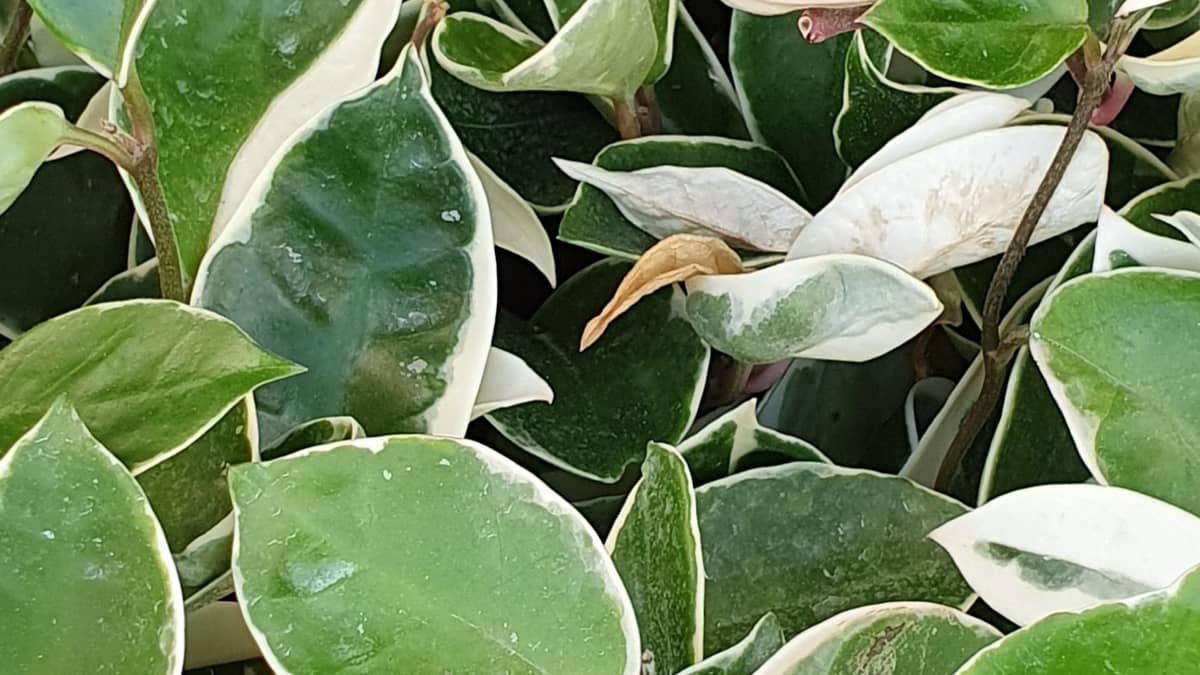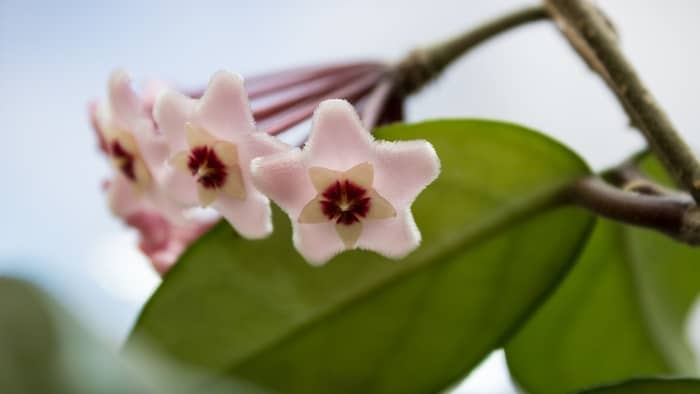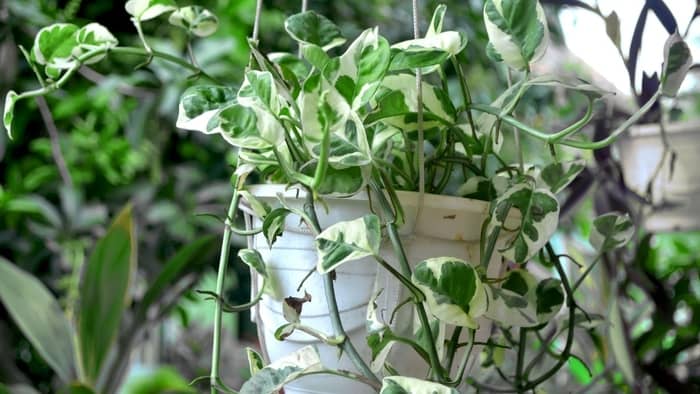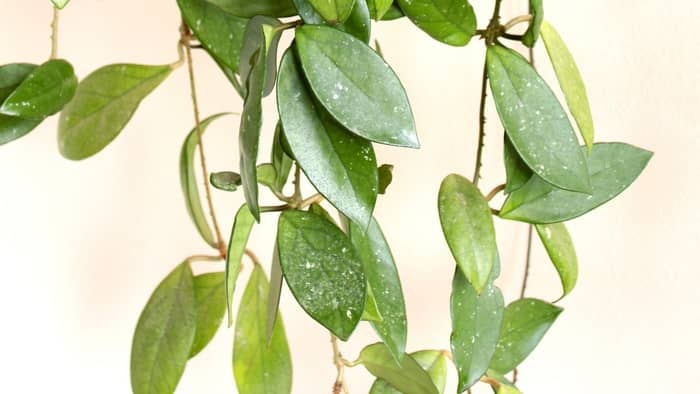Last Updated on November 27, 2021 by Guillermina
Thinking of growing Hoyas indoors? This is the best, ultimate guide on how to make your favorite houseplant happy and healthy this winter.
If you are looking for an exotic indoor plant that is very easy to grow, then Hoyas is the right choice for you. Lately, more and more people are opting for this houseplant. No wonder because Hoya plants can bring a touch of tropics into your home. They are easy to maintain, extremely durable, love indirect light and moisture.
Thinking of getting one? Well, that is great! This is our ultimate guide to growing Hoya indoors.
What Is A Hoya Plant?
Hoyas belong to the dogbane family, Apocynaceae, and are placed in the subfamily Asclepiadoideae, which are the milkweeds. Hoyas plants have thick, waxy leaves that adorn every space they are in by overflowing from the pot with their beautiful vines.
Experts estimate that today there are somewhere around 600-700 Hoya species, and many are still undescribed or unnamed. Most Hoya plants come from subtropical and tropical Asia, i.e. from Malaysia, the Philippines, Indonesia, all the way to Papua New Guinea.
As for the names, different species and varieties have different common names. You will most often come across it as a wax plant, a wax vine, or a honey plant.
Appearance
Hoyas create clusters of star-shaped flowers that are most commonly in shades of white, pink, and red. Its waxy petals look like the finest porcelain and often have pleasant fragrant notes.
These are the most favorite specimens of this exotic plant.
- Hoya carnosa – the most common.
- Hoya obovata (hardier hoya) – recognizable by its thick, round leaves.
- Sweetheart Hoya – recognizable by its heart-shaped leaves.
- Shooting star Hoya (Hoya multiflora) – due to its thin leaves it is closer to the pothos or philodendron family.
- Hoya pubicalyx – recognizable by its long and oblong leaves with soft pink spots.
Growing Hoyas Indoors
Since colder weather is coming, it would be a good idea to transplant your Hoya plant indoors.
Potting
Hoyas will grow successfully in any plastic, terracotta, or ceramic pot. Strange as it may sound, they like slightly tighter conditions (as do orchids). The tighter the pot, the better it will bloom. They are ready to change their pot only after the roots have replaced almost the entire soil. Even then, choose a pot that is 1-2 inches larger than the previous one.
Soil
Hoyas prefer a rich mix with excellent drainage. The most important thing to remember is that each Hoya variety has slightly different requirements when it comes to soil preferences. However, whatever you choose, make sure it drains well, provides excellent aeration, and doesn’t retain too much water.
Try to avoid sand as it fills open spaces and reduces the airflow required by the roots. Therefore, over time, the soil compacts and this leads to root rot.
Did you know that you can make homemade potting soil? Orchids, pine or fir bark, coco coir, pumice soil amendment, charcoal, and vermiculite – whatever comes to your mind. Everything will do a good job.
This is the simplest Hoya potting soil mix you can make: 2 parts peat moss + 1 part perlite.
Water & Humidity
Since their growth naturally slows down in the fall and winter, your Hoya plants will not need to be watered as often as on warmer days. Give them only as much water as needed so that the soil does not dry out completely. Unfortunately, many have realized too late that too much water can cause flowers to fall off.
Hoyas are tropical plants, which means they like humid conditions. When growing Hoyas indoors, be sure to use a humidifier to raise the humidity level, the ideal level is 60-80%. You can also use a saucer with gravel and water, or even mist it with room-temperature water. Let this be your Hoya plant care routine!
However, when misting, try to avoid flowers, since they aren’t exactly fans of random water showers.
Temperature
Hoya plant temperature tolerance is quite low. This is not strange, since it’s a tropical plant. Anything below 50 ° F (10 ° C) can cause cold damage. Therefore, try to keep it away from touching cold windows as well as heating and cooling vents.
Pruning
Hoya plant care consists of pruning as well. It’s is most often done to control the size, make it bushy, thin out, or remove dead growths. Also, you will not need to prune the plant while it’s growing indoors.
Exposure To Light
Make sure you give your plant a bright, natural, indirect light. They need as much bright light as possible to be able to bloom indoors. But beware; they can’t take harsh afternoon light.
Admittedly, they tolerate low light, but in these conditions, you can expect more leaves than flowers. If you’re not able to, you don’t have to worry. Their thick leaves are very beautiful as well.
Fertilization
One of the best things about growing Hoyas indoors is that they are not needed when it comes to feeding. This time is the time of their rest, which means fertilization is not required.
Excessive fertilization is not good, as it leads to the accumulation of salt resulting in burnt roots of the plant. In addition, it would be good to avoid fertilizing a houseplant that is stressed (bone dry or soaking wet).
Pests
Hoyas can be susceptible to mealybugs. You will most often find them in the nodes and under the leaves. Also, watch out for scale and aphids.
Click here to read more about it.
To Wrap Things Up
Hoya is one of those flowers that brings exotic and tropical notes into your home. The basic steps of caring for Hoya plants are: let them dry between waterings and provide them with plenty of bright and indirect light.
They smell sweet, look nice, are non-toxic to pets, and are easy to maintain. Is there anything else that would convince you to start growing Hoya indoors this season?
If you have any questions, write to us below!
Also, read more about Crucial Tips For Growing Star Jasmine Indoors




